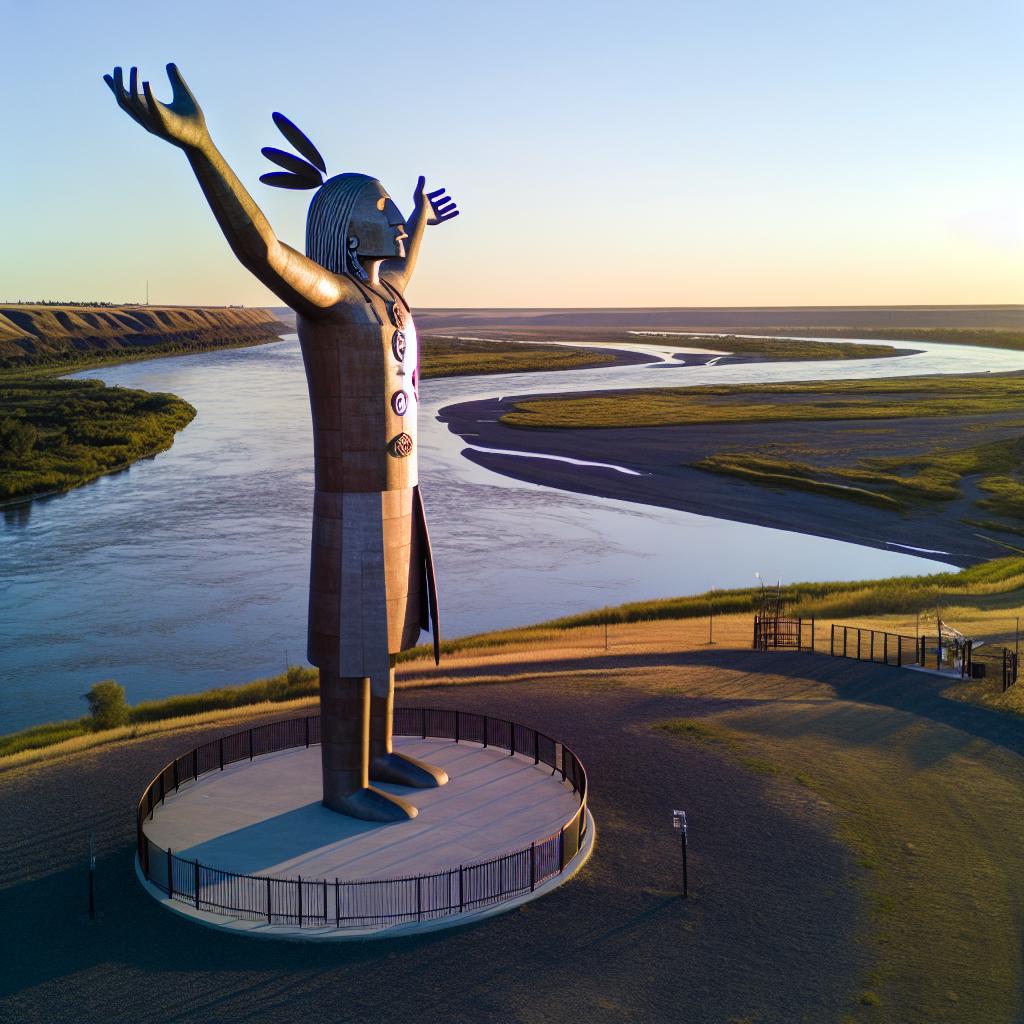The Keeper of the Plains Statue: An Iconic Landmark
Located in Wichita, Kansas, the Keeper of the Plains statue is an impressive piece of public art that stands as a symbol of Native American heritage and the confluence of the Big and Little Arkansas Rivers. Created by artist Blackbear Bosin and erected in 1974, the statue is a celebrated focal point in the city. It manifests the intertwining of past and present, linking the area’s historical significance with contemporary appreciation.
Design and Symbolism
The statue is 44 feet tall and is made of corten steel, which gives it a distinctive rust-colored finish. This choice of material is not only aesthetically striking, allowing the statue to stand out against the sky, but also practical, as corten steel is known for its weathering properties, ensuring durability against the elements. The design of the statue depicts a Native American warrior with raised hands, a gesture often interpreted as a prayer giving thanks to the Great Spirit. This iconic figure is illustrated wearing a traditional headdress, and the artistry reflects the profound respect for nature and the spirit world characteristic of Indigenous cultures. This depiction and the materials used not only highlight the artistic talent of Blackbear Bosin but also emphasize the cultural values intrinsic to Indigenous communities.
Historical Background
Blackbear Bosin, the artist behind the Keeper of the Plains, was a noted Kiowa-Comanche artist known for his work celebrating Native American history and culture. Bosin provided this iconic statue as a gift to the city of Wichita, intending it as a permanent reminder of the rich Indigenous presence and heritage in the region. His background as a Native American artist imbued his work with genuine insight and a profound connection to the themes he explored through his art. Bosin’s dedication to embodying Native American stories and traditions in his art has been pivotal in fostering a broader understanding and appreciation of Indigenous cultures among diverse audiences.
Site and Accessibility
The statue is placed strategically at a point known as the confluence, where both rivers intersect. It is reachable via two pedestrian bridges, allowing easy access for visitors to get an up-close view of this cultural monument. These bridges not only serve as functional pathways but also offer a transitional space that prepares visitors for the cultural significance of the site they are about to experience. At night, the statue is illuminated by surrounding torches, creating a spectacular visual experience known as the “Ring of Fire.” This ceremony occurs at 9 PM during the spring and summer months, and at 7 PM during fall and winter, weather permitting. The lighting ritual transforms the already majestic statue into a beacon of cultural symbolism visible from afar, drawing both locals and tourists to partake in the visual feast while deepening their appreciation of the heritage it represents.
Visitor Amenities
The Keeper of the Plains is part of a larger park area that includes walkways, educational displays, and seating areas for visitors. These features are designed not merely for comfort and convenience but are structured to encourage reflection and learning. An information plaza near the statue provides additional historical context and insights into Native American traditions, crafted in collaboration with Indigenous community representatives and scholars. This ensures that the educational content shared with the public is accurate and respectful, furthering the goal of cultural preservation and awareness. By incorporating these elements, the site offers a comprehensive experience that educates and inspires, helping visitors to forge a deeper connection with Indigenous cultures.
Continued Significance
Over the years, the Keeper of the Plains has become more than just a local landmark; it’s a site of cultural education and community gatherings. Different events related to art, history, and Indigenous communities are held there, reinforcing the site’s role as a cultural hub. It plays a pivotal role in various events, including annual Indigenous celebrations and various local festivities, solidifying its status as a revered cultural emblem. These events serve as opportunities for the community to come together, celebrate their shared history, and engage in activities that promote cultural learning and unity. The Keeper of the Plains thus serves as a living testament to Indigenous peoples’ resilience and enduring influence in the Wichita region, offering an enduring reminder of their vital contributions to the area’s past, present, and future.
The Keeper of the Plains stands as a powerful tribute to the area’s Indigenous peoples, embodying their enduring legacy and influence within the Wichita region. In celebrating their art, culture, and history, it serves as both an educational tool and a symbol of unity, reminding us of the deep historical roots from which current socio-cultural landscapes have grown. This momentous statue not only highlights the importance of honoring Indigenous cultures but also emphasizes the perpetual relevance of these cultures in shaping contemporary society. As the statue continues to attract visitors, its role as a cultural and historical point of reflection becomes ever more significant.

